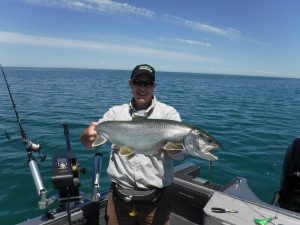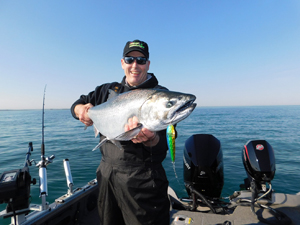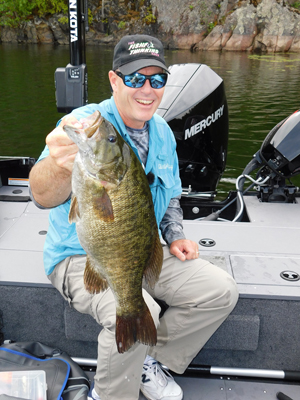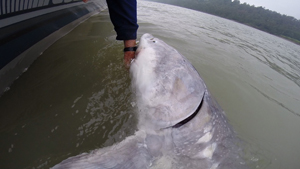 Without a doubt, downriggers are the best way to present a lure or bait in deep water. Most anglers associate downriggers with suspended fish, and target fish holding at specific depths and preferred temperatures, but don‘t neglect the fish holding structure at the bottom. While it is true that fishing close to the snag infested bottom can pose many threats to a passing cannonball or lure, these areas often hold loads of undisturbed lunkers. Salmon, Trout, Walleye, Muskies or whatever deep-water species you target, there is always a time to fish close to the structure on the bottom, and trolling with a downrigger is the best way to cover the water and find your active fish.
Without a doubt, downriggers are the best way to present a lure or bait in deep water. Most anglers associate downriggers with suspended fish, and target fish holding at specific depths and preferred temperatures, but don‘t neglect the fish holding structure at the bottom. While it is true that fishing close to the snag infested bottom can pose many threats to a passing cannonball or lure, these areas often hold loads of undisturbed lunkers. Salmon, Trout, Walleye, Muskies or whatever deep-water species you target, there is always a time to fish close to the structure on the bottom, and trolling with a downrigger is the best way to cover the water and find your active fish.
If you are lucky enough to be fishing an area with only limited snags and obstructions, one of the best ways to attract attention and also turn on inactive fish, is to drag your downrigger weight across the bottom. With a mostly sand or muddy bottom, anytime the bottom is disturbed, this kicks up a trail of debris, just like feeding fish would, or escaping prey and turns on the fish and into an aggressive feeding pattern. Even totally inactive fish can be persuaded to take a whack at the lure. Walleye, Smallmouth Bass, Lake Trout and Salmon all fall victim with this very effective technique. It helps greatly to add a downrigger trolling snubber, this 12-inch-long piece of shock absorbing material is clipped on between the downrigger weight and the end of the downrigger cable. It is a small addition, but helps incredibly to keep your weights from snagging as this helps to flex and bounce you across the bottom. It is also essential to use the standard round cannonball shaped weights for this technique, save the unique fish shaped and other weights for suspended fish.
A crawling worm harness 50 feet behind the dragging weight, just as the clouds of silt from bottom contact start to thin out is deadly for Walleye. Smallmouth Bass are much more aggressive and will dive straight into the debris line, often looking for tidbits even 5 feet behind the cannonball looking for a confused Crayfish. An assortment of floating crank baits and minnow imitations all work, as do plastic tubes simply dragged behind as close as 5 feet to up to 25 feet. With the slower boat speeds used for worm harness and tubes, as well as using these techniques in shallower waters, downrigger weights can be decreased. As long as bottom contact is still made, and lures are working correctly, all systems are a go!!
For Salmon and Lake Trout, dragging the bottom is more of an inactive approach to get these monsters up and feeding. The bottom dragging still gets them moving, but it is a much more subtle hit and lure presentation. Boat speeds are usually kept to between 1.5 and 1.7 mph, and a close eye to any changes in the bottom tapping rhythm can indicate a hit. Lake Trout are eager takers to the presentation directly in the debris line and close to the bottom with gang trolls and a small spoons or offerings only 24 inches behind the last spinning blade. Salmon are attracted to the debris, but prefer a presentation above and back from the disturbance.
For the Salmon, buoyant lures with great action at a slower speed are best for this. It allows the baits to hover up and away from the bottom and up into the oncoming curious Salmon. Lures are usually run back 20 to 50 feet depending on the activity level of the Salmon. Precision line counter reels like the Daiwa Saltist and Sealine make it very easy and accurate to repeat the successful amount of line out each time. Avoid trolling at speeds that will make the lures dive, you want to keep it wobbling enticingly and still floating up from the bottom. Find the magic speed and hold on!!
As always, play with lure colours, depending on light penetration and thickness of the clouds of debris kicked up, it can be very important. Remember, hits will not usually be the slam from a Salmon that you maybe use to. At these slower speeds and with the fish generally inactive, hits usually start as only a light bump and slight pull. Do not wait for the release to pop, you will miss many fish. As soon as a hit is noticed, (and it might only be a slight “tick”) it might be necessary to reel down, release and set the hook yourself. It is very common for these Salmon to only mouth the baits, for this reason, keep hooks as sharp as possible to help hook sets and extend your precious few seconds to detect a hit. I change all my hooks to the sticky sharp Mustad Ultra Points for this reason.
The Lake Trout are a different story, and will stick their noses directly in the debris line. The flash of a gang or lake troll (3 or 4 large spinner blades) with a small wobbling lure or bait following does an incredible job. Baits rigged only 2 feet behind the last spinning blade, are just the kicked up little snacks the Lakers are looking for. Small crankbaits and small spoons are idea, but everyday is different. Some days only 10 feet behind the dragging downrigger weight is the magic ticket, other days, up to 30 feet. When two rods are used, I like to stagger the distances, with one close to the ball the other back at least 20 feet and let the fish tell you what they want. Many days, the first acts like an attractor with the second getting regularly slammed!! Pay attention to the successful distance of lead so you can repeat again with your line counter reel. Being dragged in the debris line does cause some abuse to the tackle, so using the highly abrasion resistant Seaguar Fluorocarbon not only gives a nearly invisible presentation, but the Fluorocarbon leader material is extremely tough. Seaguar is not only very abrasion resistant, but almost invisible to the fish, so a much stealthier approach. While Seaguar Fluorocarbon and Mono look very much alike out of the water, in the water it is 2 different views. Seaguar Fluorocarbon almost has the same refraction level as water itself, so in the water it is next to invisible.
When I talk about dragging the bottom, I do mean dragging. It is not uncommon to be fishing in 80 feet of water with 100 feet on the downrigger counter, just make sure your downrigger tension knob is set properly to slip if a snag occurs, its not a good situation to see what breaks first with 250 lb wire cable. Have cutters handy just in case of a mishap.





